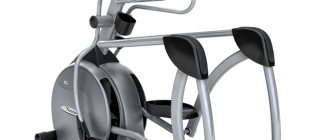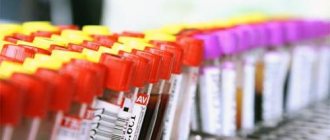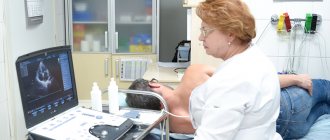Electrophoresis is a physiotherapeutic procedure during which an electric current is applied to the human body. Electrophoresis is used to administer drugs through the skin or mucous membrane. Preparations for electrophoresis are varied and are selected depending on the disease to be treated. Quite often, electrophoresis is performed with aminophylline, a drug that improves blood circulation, eliminates pain, and dilates the bronchi. The procedure should be prescribed exclusively by the attending physician. You should not resort to self-medication, as this can negatively affect your health.
At the Yusupov Hospital, you can get advice on the need to perform electrophoresis with aminophylline from the best specialists in Moscow, as well as undergo a course of treatment for the disease. At the rehabilitation center, experienced rehabilitation therapists and physiotherapists perform complex treatment of various pathologies using effective techniques, including electrophoresis.
The concept of electrophoresis, indications, restrictions on the purpose of physiotherapy
Electrophoresis is used for medicinal purposes in various pathologies during the recovery period of an acute illness, as well as during remission in a chronic illness. Electrophoresis in children and adults is often necessary to administer the drug. A very large number of medications are not used in children due to their young age.
Administration of the drug using electrophoresis allows the use of prohibited drugs, since the dosage of the active substance entering the blood is too small. They do not have negative effects on the baby’s body; they bring only positive results.
Electrophoresis involves the use of direct current. It is generated by special devices and supplied to the patient’s tissues using electrodes. The devices have 2 types of electrodes: cathode, anode. By interacting with each other, they move charged particles in the body. The cathode is the negative electrode. It attracts positively charged ions. The anode is the positive electrode. Negatively charged particles tend to it.
Together with the ions, the medicinal substance enters the tissue. The choice of medication depends on the type of disease. For physiotherapy, you can use Papaverine, Trental, Eufillin, Nicotinic acid, Potassium iodide and other drugs.
For electrophoresis, only direct current is used.
In physiotherapy, constant and dynamic current can be used. Dynamic currents are much more complex and have different character and intensity.
Types of devices
| Type of impact | Devices |
| Galvanization | AGN-32, AGP-33, “Potok-1”, GR-1, GR-2 – for the oral cavity; AGVK and GK-2, “Eter”, “DTGE-70-01”, “Elfor”, “Radius-01”, Electrostim 180. |
| Direct current (pulses) | "Electroson-3", "Electroson-4t", "Electroson-5". |
| Diadynamic current | “Tonus-1”, “Tonus-2”, “DTGE-70–01”, “Radius-01”, Bipulsator, Diadinamic DD-5A, Dinamed, Neuroton |
| Sinusoidal currents | "Stimul-1", "Stimul-2", "Radius-01" |
General indications for electrophoresis:
- Diseases of the pulmonary system.
- Pathology of ENT organs.
- Diseases of the digestive tract.
- Diseases of the heart and blood vessels.
- Pathologies of the pelvis in women and men.
- Disorders of the motor system.
- Neurological diseases.
- Skin diseases.
For children, electrophoresis is indicated for hypertonicity or hypotonicity of skeletal muscles, pain of various localizations, birth trauma, joint diseases, neurological diseases, stomatitis, colitis, cystitis, severe diathesis, sore throat, hepatitis.
Restrictions on the use of the procedure: cancer, insufficient heart function, acute inflammation, status asthmaticus, hyperthermia, wounds or inflammation of the skin, blood clotting disorders, changes in sensitivity, current intolerance, allergy to medication.
Osteochondrosis is a chronic disease of the spine, expressed in dystrophic changes in osteochondral structures and leading to a decrease in its functionality. Pathology has become so widespread in the world that it is often not perceived as a serious problem. Discomfort in the lower back or neck does not cause much concern in adults, especially since they go away after taking the pill or on their own. Such a frivolous attitude is the main cause of numerous complications of osteochondrosis, when surgical intervention or long-term therapeutic treatment of the spine is required.
Osteochondrosis used to occur in adults, usually after 35–40 years, but nowadays people of young and adolescent age turn to doctors. Timely detection of pathology and the prescription of competent treatment is a guarantee of successful restoration of the functions of the musculoskeletal system and prevention of further development of degenerative processes in spine .
Types of disease
With osteochondrosis of the spine, the pathological process involves the vertebrae, fibrous ring, intervertebral discs , neurovascular bundles, muscles and tendons. Depending on which department has undergone changes, the classification of osteochondrosis is as follows:
- cervical;
- chest;
- thoracolumbar;
- lumbar;
- lumbosacral.
The disease manifests itself in a variety of symptoms, the severity of which depends on the force of compression of the nerves in the intervertebral foramina, as well as the intensity of the inflammatory process. The most unpleasant and, unfortunately, common complication is rupture of the fibrous ring, which leads to prolapse of the nucleus pulposus, compression of nerve endings, blood vessels, and in severe cases, the spinal cord.
Symptoms
The main symptoms of osteochondrosis are pain, discomfort, stiffness, and numbness in the affected area. The pain can be sharp, shooting, aching, sudden or constant. Very often, painful sensations spread to other parts of the body - they radiate to the lumbar region , arm, leg, shoulder, head. It all depends on the degree of damage to the spine and the localization of the pathological process.
Cervical osteochondrosis leads to constant headaches, and when the thoracic region is affected, the same symptoms are observed as with heart disease: a feeling of heat in the chest area, difficulty in inhaling, shooting pain under the scapula, in the shoulder joint. With lumbar osteochondrosis, there is often a feeling of tingling or numbness in the legs. Over time, a person’s posture changes, muscles and ligaments lose elasticity, blood circulation worsens, and congestion develops in the tissues.
Diagnosis and treatment
The main methods for diagnosing osteochondrosis are radiography of the spine, magnetic resonance imaging (MRI), computed tomography (CT). Based on hardware tests, the doctor makes a diagnosis and draws up an individual treatment plan.
Treatment programs imply an integrated approach, using medications (eliminate inflammation), physiotherapeutic methods, and physical therapy. Surgeries are indicated in cases where there is a threat of serious complications, in the absence of effectiveness of conservative regimens.
Types of physiotherapy for osteochondrosis
Physiotherapy is a list of techniques based on the effects of natural or artificially created medicinal substances and physical factors on the human body. During physiotherapy, various types of medical equipment with a certain type of impact are used. The main goals of physiotherapy for osteochondrosis are eliminating pain, stimulating microcirculation and tissue regeneration, suppressing the inflammatory process, relieving muscle tone and spasms, and normalizing metabolic processes.
The main methods of physiotherapy used in the complex treatment of osteochondrosis include:
- electrotherapy (electrophoresis, diadynamometry, amplipulse therapy);
- magnetic therapy;
- laser therapy;
- ultraphonophoresis;
- amplipulse therapy.
Many methods of physiotherapy for osteochondrosis are prescribed only when positive dynamics are established, after completing a course of drug treatment, or in a stable condition, when exacerbations are not observed for a long time. But there are other methods that are prescribed in the acute period: for example, magnetic therapy, laser treatment, short-pulse electroanalgesia. The type of physiotherapy is chosen by the doctor, taking into account the characteristics of the disease, age, localization of the pathology, and the presence of relative contraindications.
Electrophoresis is one of the oldest methods of physiotherapy , which involves the introduction of drugs under the skin under the influence of a weak current. This method is most often used for cervical osteochondrosis . Charged particles penetrate the area of inflammation and accumulate there, providing a therapeutic effect. The duration of action of medications reaches 12–15 hours, which is the basis for achieving a high therapeutic effect. As a rule, doctors add massage, mud applications, turpentine baths and other procedures to electrophoresis.
Magnetic therapy is the effect of a magnetic field on the affected area. In physiotherapy , low-frequency, high-frequency, alternating, and pulsed magnetic fields are used. Treatment is used for osteochondrosis of all parts of the spine . The intensity and time of exposure to the field is set by the doctor using a special device (device). This type of physiotherapy allows you to normalize lymph flow, eliminate pain by blocking nerve fibers, improve the rheological properties of blood, enhance the effect of other types of treatment, and also eliminate muscle spasms.
Amplipulse therapy is a method of physiotherapy based on the use of alternating sinusoidal currents with a given frequency. Amplipulse helps eliminate swelling in inflamed tissues, relieve pain, and improve blood circulation. It has been proven that the use of the technique has a beneficial effect on the functioning of the peripheral nervous system. For physiotherapeutic treatment of osteochondrosis of the cervical spine , currents with a frequency of 80–100 Hz are used; for the thoracic region and lower back, parameters are set from 30 to 50 Hz. The procedure is carried out daily or every other day, at least ten times.
Ultrasound therapy is a method of physiotherapeutic treatment based on the effect of ultrasound radiation on cartilage tissue, muscles and bone structures. To carry out the procedure, a special device with a software package is used, where the parameters of the ultrasonic flow are set. The inclusion of physiotherapy in the treatment complex gives excellent results in the treatment of lumbar cervical osteochondrosis and other types of the disease. After a course of procedures, microcirculation is activated, swelling is reduced, the inflammatory process is softened, and muscle spasms are relieved.
Galvanization is the application of continuous low voltage electric current to the affected area. The energy penetrating into the body triggers complex physical and chemical processes, as a result of which metabolism is activated, muscles relax, and the intensity of inflammation in the lumbar, thoracolumbar, and cervical spine . The course of treatment consists of 12–14 procedures, the duration of which varies from 20 to 40 minutes.
Ultraphonophoresis is a physiotherapeutic treatment of osteochondrosis using medications administered through the skin into tissues using ultrasound energy. After a course of sessions, stabilization of the nervous system, increased elasticity of cartilage and muscle tissue, and a pronounced analgesic effect that is maintained for a long time are observed. As after other physiotherapeutic procedures , blood circulation is encouraged and tissue nutrition is improved.
Laser therapy is the treatment of the spine using laser radiation that is converted into thermal energy. This progressive method of physiotherapy has a number of valuable advantages - it:
- has a targeted effect (the laser beam does not affect healthy tissue, but acts within a given segment);
- triggers the regeneration mechanism of new cells, activates metabolic processes;
- activates blood flow, improves microcirculation;
- gently and deeply warms tissues;
- eliminates radicular syndrome;
- lasts a short time (10 minutes);
- strengthens the body's immune forces;
- increases the absorption of drugs.
Contraindications to laser treatment of osteochondrosis are diseases of the hematopoietic organs, cancer, post-stroke and post-infarction conditions, dermatoses in the area of exposure and some other conditions.
Advantages of treating osteochondrosis at the Profmedcenter clinic
The Profmedcenter clinic has the latest medical devices used in physiotherapy for the treatment of osteochondrosis . Our specialists will quickly conduct an examination, make the correct diagnosis and prescribe treatment according to an individual program. Experienced doctors with successful professional experience carefully select therapeutic regimens, taking into account the age of the patients, the nature of the pathology, and the expected effects of conservative treatment.
Patients will not have to stand in line for an appointment with a specialist, a diagnostic examination or a physical therapy . We value the time of our clients and staff, so we do not allow any downtime. Attentiveness, friendliness, provision of information of interest in an understandable form are the priorities of our clinic. If you have any questions, call +7 (473) 202–2–602 during business hours.
Effect of Eufillin on the body
Eufillin is used very often in pediatric practice. The medicine is administered using an electric current. The dosage of the drug is prescribed only by the attending physician.
Properties of Eufillin:
- The medicine works as an antispasmodic, relaxing the smooth muscles of internal organs.
- Expands the lumen of the bronchi due to the bronchodilator effect.
- Has a hypotonic effect.
- Increases diuresis.
- Causes an increase in heart rate.
- Dilates blood vessels and bile ducts.
The main effect of the drug is relaxation of muscles, increased oxygenation of tissues and organs, and increased blood flow.
Indications for the use of electrophoresis in infants under one year of age:
- Hypotonicity of skeletal muscles.
- Increased muscle tone.
- Hip dysplasia.
- Hypoxic damage to brain tissue.
- Pain syndrome of various localizations.
- Hydrocephalic syndrome.
- Stagnation of blood in tissues.
Administration of Eufillin up to 3 years of age is permitted only by electrophoresis. This use of the drug helps to eliminate the occurrence of unwanted systemic effects. However, even when the medicine is administered by electric current, undesirable effects may occur.
Side effects of Eufillin:
- Headache.
- Poor sleep, difficulty falling asleep.
- Tremors in the baby's arms and legs.
- Allergic reaction to a drug, etc.
When should treatment be prescribed?
Defectologists, psychologists, and speech therapists claim that up to the age of 3, a child can independently catch up with the speech activity of his peers. If this does not happen, a set of procedures is prescribed.
electrophoresis sessions are aimed at stimulating neurons in the cerebral cortex and spinal cord. Modern transcranial magnetic therapy , aimed at the headband area, can improve the functioning of nerve endings in this area, improve metabolic processes, and restore blood circulation.
Rules for electrophoresis with Eufillin
To carry out a physiotherapy procedure, the doctor prescribes in the prescription sheet the concentration of the medicinal substance, the duration of the physiotherapy procedure, and the duration of the course therapy. During physical therapy, depending on the disease, the location of the electrodes will vary.
If the baby has a violation of the tone of the arm muscles, then electrodes are applied to the shoulder and neck area. If there is a change in the tone or movement of the leg muscles, electrodes are placed on the lumbar area (lower back). When a child has hip dysplasia, electrodes are also fixed to the pelvic region. Electrodes should be applied to the collar area (neck) in case of hypoxic brain damage, developmental delay, or hydrocephalic syndrome.
To install the electrodes you will need gauze or a special thin cloth. The gasket is well moistened with Eufillin medicinal solution (1 or 2 percent). The most commonly used concentration is 2.4%. The electrodes are wrapped in moistened gauze to avoid skin burns. They are placed on the required area, and then the device is turned on.
The average duration of one session for babies under 1 year is 5-10 minutes. If current tolerance is poor, the time of physiotherapy can be reduced or treatment can be canceled altogether. Usually the child does not experience any discomfort during electrophoresis.
Some babies may experience severe tingling where the electrodes are placed. In this case, the current intensity should be reduced. If an allergic reaction to a drug component occurs (which sometimes happens in children), therapy is stopped. The drug should be replaced with another, safer one.
The principle of choosing methods of physiotherapy for delayed speech development
Delayed speech development is not always associated only with problems of the speech apparatus, often these are manifestations of disorders with vision, hearing, nervous system , these can be the consequences of negative influences during intrauterine development, as well as if a natal injury has been diagnosed. Physiotherapy is prescribed for delayed speech development if in early childhood the child suffered injuries or certain viral diseases , infections, and such factors provoked a complication.
Simultaneous administration of Eufillin with Papaverine or Novocaine
Eufillin can be combined with Papaverine and Novocaine. Papaverine has a pronounced antispasmodic effect on the smooth muscles of blood vessels and hollow organs. The drug relieves pain well and dilates blood vessels.
For infants, physiotherapy with Eufillin and Papaverine is necessary for:
- birth trauma;
- torticollis;
- cerebral palsy (CP);
- pathologies of metabolic processes (especially carbohydrate).
Papaverine with Eufillin is used according to the Ratner method. It consists of installing an electrode with Eufillin on the cervical region, an electrode with Papaverine on the chest on the right side. The technique cannot be used if the child (newborn) has glaucoma, allergies to medications and current, or insufficient liver function.
Novocaine has a strong analgesic effect. It is used together with Eufillin for high intensity pain syndrome. Pain occurs in patients with cerebral palsy. Painful sensations are caused by muscle spasms, contractures and other associated pathologies. An electrode with Novocaine is placed on the area of pain.
The duration of one physiotherapy procedure is 10-15 minutes. Course therapy – 10 physiotherapeutic procedures. If necessary, treatment can be continued. Therapy can be carried out daily or every other day.
Properties of Eufillin
Eufillin is a drug with bronchodilator properties. They are used when a severe allergic reaction or other pathology occurs, accompanied by spasm of the respiratory tract. It can be administered not only using electrophoresis, but also intravenously. This method will speed up the onset of the drug effect, but may cause side effects.
The drug is able to block bronchial receptors, thereby reducing their response to irritants. It has antispasmodic, tocolytic and diuretic properties. Although the latter is a side effect and is not used in the treatment of diseases.
Under the influence of Eufillin, spasm of the smooth muscles of the respiratory tract is relieved, blood circulation and tissue trophism are improved, and pain is reduced.
A sufficient amount of oxygen begins to enter the body, which has a positive effect on the patient’s well-being. In some cases, the drug can save a person’s life.
Eufillin is prescribed as a medicine for bronchial asthma of physical exertion or as a component in complex therapy. It is used for emphysema, obstructive bronchitis and respiratory failure associated with cardiac pathologies. The drug helps relieve pulmonary hypertension, lower pressure inside the skull and correct blood circulation in the brain.
Carrying out electrophoresis with Euphyllin and Nicotinic acid
Often in physical therapy for children, a combination of Euphyllin and Nicotinic acid is used. This treatment is indicated in the presence of hypertonicity, hypotonicity of skeletal muscles in children, birth trauma, and hydrocephalic syndrome. The efficiency of electrophoresis is quite high.
After the treatment, in patients with changes in tone, tremor in the arms goes away, the position of the arms and legs becomes physiological. If a child has hydrocephalic syndrome, then the use of Eufillin and nicotinic acid normalizes or reduces intracranial pressure. When using drugs, the production of spinal fluid in the ventricles of the brain decreases. This is clearly visible during neurosonography. During therapy, the baby's constant crying goes away, sleep normalizes, and bulging of the large fontanel is not observed.
If there is a birth injury, the child may have trouble holding his head up. When performing electrophoresis with Eufillin on a child’s cervical spine, the strength of the posterior group of neck muscles improves. With cerebral palsy, the stiffness of the neck muscles decreases.
Nicotinic acid can increase the regenerative function of skin cells and mucous membranes and dilate blood vessels. The use of the drug accelerates the exchange of microelements in tissues and reduces cholesterol levels. With frequent physiotherapy with nicotinic acid, blood flow increases in the brain tissue.
Nicotinic acid cannot be used for long periods, as it can cause fatty degeneration of liver cells.
Contraindications
The procedure is not performed if you are allergic to the drug used. If this point becomes clear after the prescription, and treatment is vital, the medicine is replaced with its analogue with the same effect. Instead of Eufillin, in the presence of spasms, papaverine or magnesia is used.
Most contraindications to the procedure are relative. Treatment can be carried out after they are eliminated. Such situations include:
- violation of the integrity of the epidermis at the site of application of the electrode;
- dermatological pathologies in the acute period;
- arrhythmias of any kind;
- neoplasms of various types (malignant and benign);
- fever of any etiology;
- arterial hypertension;
- heart failure;
- negative reactions of the body to the action of electric current.
The presence of contraindications to treatment is clarified by the doctor before prescribing the procedure. If therapy cannot be postponed until the pathology is eliminated, other methods of influence are selected. In some cases, drugs are replaced with analogues so as not to cause a negative reaction in the patient.
Electrophoresis for infants at home
The electrophoresis physiotherapy procedure can be done at home. Before using the technique, you should consult your doctor. The doctor will help you choose the appropriate device for therapy and teach you how to correctly install the electrodes. The doctor will explain how to prepare the medicinal solution. It is necessary to check with your doctor the correct settings for the device, especially the current intensity. In children, low current is used.
On the recommendation of a doctor, you need to purchase an electrophoresis device. It is bought in medical equipment stores. The device can also be ordered from online stores specializing in medical products.
When purchasing, you need to ask for certificates of quality and conformity for the device. It is better to check its operation immediately in the store. The device must be accompanied by a warranty card. It gives the right to replace the device if there are any malfunctions.
For the physiotherapy procedure you will also need a medicinal solution (Eufillin, Novocaine, Nicotinic acid, Papaverine). The choice of solution and concentration (in percentage) is determined by the doctor. You can buy medications at a pharmacy or online pharmacy. It is imperative to know the concentration of the substance. When purchasing a drug, you should look at the expiration date. Before use, you must read the instructions.
At home, you should wrap the electrodes well in gauze. There should be at least 8 layers. This will help avoid burns and prevent discomfort during physical treatment. Electrodes are placed on the cervical region, back, and lumbar spine. The location of the electrodes depends on the disease. During the physical procedure, you need to monitor the baby. You cannot continue the session if the child is very capricious and kicks his legs.
After the session, you should definitely inspect the area where the electrodes are applied. Normally, there may be slight redness at the site of the pads. When the hyperemia is very strong, and swelling, rash and itching increase in the area where the electrode is applied, treatment should be stopped and the child should be given antihistamines (Suprastin). If necessary, you need to call a doctor at home or come to an appointment with your local pediatrician.
How do physical therapy sessions work for speech delay?
Magnetic therapy and medicinal electrophoresis procedures are prescribed in a complex manner . Initially, the session time is specially shortened in order to monitor the child’s reaction. On average, a course of treatment consists of 10–12 procedures . Physiotherapy procedures for delayed speech development at the First Children's Medical Center are carried out under the supervision of specialists in a separate room. All hardware is certified and approved for use. The medical staff will help the child feel safe and able to tolerate painless procedures. If parents wish, they can be present during medicinal electrophoresis or magnetic therapy.
Additional methods include working with defectologists and correctional specialists, increasing the time spent with the child, activating social skills, and communicating with peers. Physiotherapy for delayed speech development can be prescribed at intervals of 2–3 months in the absence of contraindications. After courses of magnetic therapy and medicinal electrophoresis, improvements are noticeable in coordination of movements, motor function, as well as in psychological development: speech reserve increases, activity in communication with other children appears, and the range of knowledge expands.
To make an appointment with a doctor
Choose a doctor
Possible alternatives
Among the physical procedures, there are several with a similar effect. The leader among them is phonophoresis. It is carried out using ultrasound. Due to the absence of an electrical component of therapy, the technique is suitable for patients with current intolerance.
The disadvantage of this tactic is the partial destruction of the drug under the influence of ultrasound. Therefore, an analogue with a similar effect is selected for treatment. But the result of the procedure and the indications for use are very similar. Therefore, the techniques are considered interchangeable.
Problems with the lower back and neck can be successfully solved using manual techniques. Osteopathy techniques are especially popular. In some cases, therapeutic massage is indicated. But it has a significantly larger number of contraindications.
An osteopathic doctor works not only with diseases of adults. It helps relieve hypertension in infants, preventing the development of possible pathologies. During the session, the child does not experience any unpleasant sensations. A full course of treatment will not only relieve existing problems, but will also prevent neurological diseases.
Before starting any course of physiotherapy, you should make sure that it is necessary. Electrophoresis with Eufillin is prescribed only according to indications, and the dosage of electrical influence and the amount of the drug are selected individually. Following these rules will help you get rid of existing pathologies without complications or side effects.










